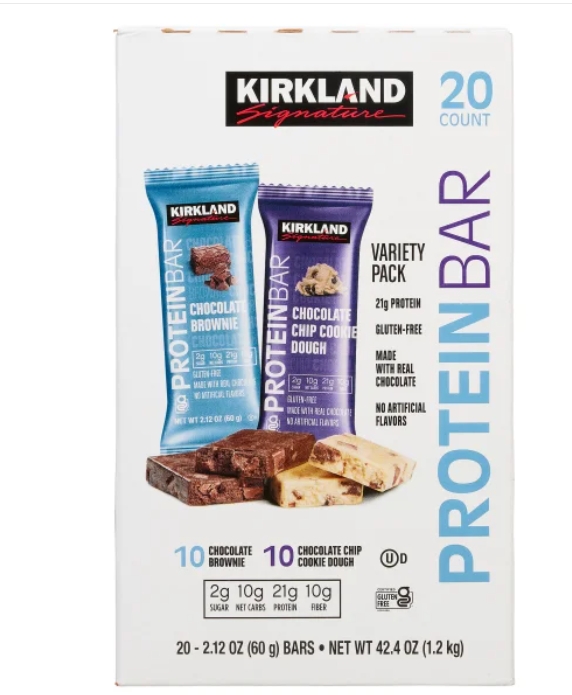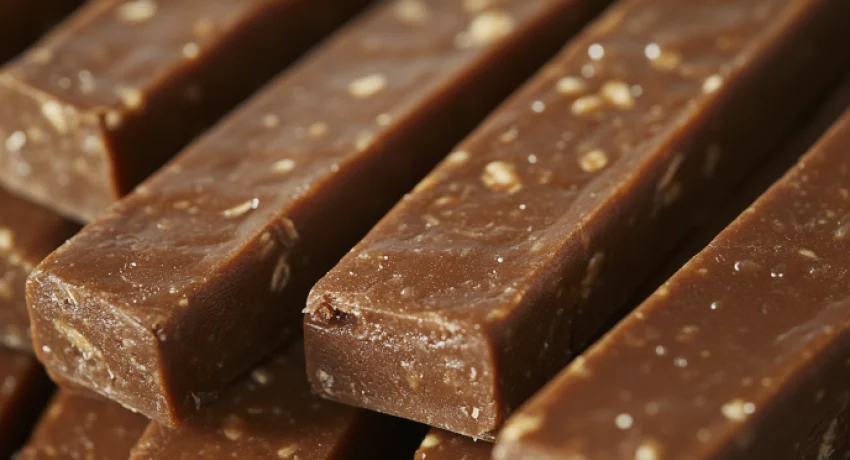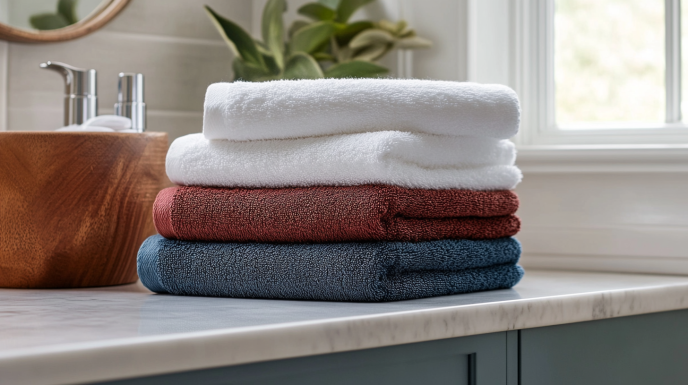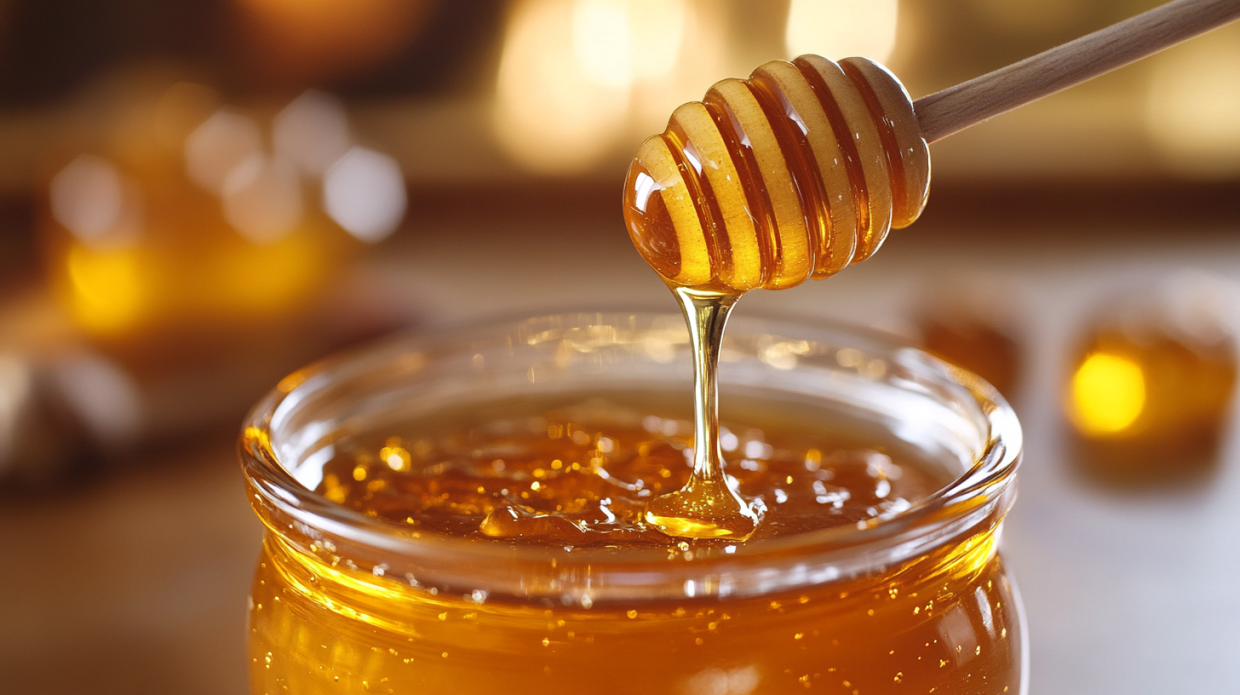
Kirkland Signature Protein Bar, Variety Pack, 2.12 oz, 20-count
- 10-Chocolate Chip Cookie Dough
- 10-Chocolate Brownie
- Made with Real Chocolate
- Gluten Free
- Kosher Dairy
Fueling Your Active Lifestyle Without Breaking the Bank
In the ever-expanding universe of protein bars, finding the perfect balance between nutrition, taste, and affordability can feel like searching for a needle in a haystack. Enter Kirkland Protein Bars – the Costco treasure that has fitness enthusiasts and budget-conscious shoppers alike buzzing with excitement. As someone who’s cycled through countless protein bar options over the years, I’ve developed a particular fondness for these unassuming yet impressive nutritional powerhouses. Let me take you on a deep dive into everything you need to know about Kirkland Signature Protein Bars – from their nutritional profile to how they stack up against premium competitors at nearly half the price.
What Exactly Are Kirkland Protein Bars?
Kirkland Signature Protein Bars are Costco’s house-brand protein bars that have gained something of a cult following in fitness communities. These bars are Costco’s answer to higher-priced protein bars on the market, particularly Quest Bars, which they’re often compared to in terms of nutritional profile and texture.
What makes these bars stand out in the crowded protein bar market is their impressive combination of high protein content, relatively low sugar, and most notably, their value proposition. When you’re going through multiple protein bars a week (as many active individuals do), finding an option that doesn’t drain your wallet becomes incredibly important.
The bars come in a distinctive box with the familiar Kirkland Signature branding – that reassuring symbol of Costco quality that members have come to trust across countless product categories. Each bar is individually wrapped, making them perfect for tossing in your gym bag, keeping at your desk, or stashing in your car for post-workout recovery on the go.
Where to Find These Popular Protein Powerhouses
The most obvious place to purchase Kirkland Protein Bars is, of course, at Costco warehouse locations. You’ll typically find them in the snack aisle alongside other protein and nutritional bars. If you’re a Costco member, this is going to be your most cost-effective option.
Don’t have a Costco membership? Don’t worry – these bars have become popular enough that they’re now available through other channels. You can find them on Amazon, though typically at a markup from the in-store Costco price. Occasionally, you might spot them on other online retailers or even in Facebook marketplace listings from entrepreneurial Costco members looking to resell them.
However, it’s worth noting that the best deals will always be found in-store at Costco. The membership fee quickly pays for itself if you’re a regular consumer of protein bars, considering the savings compared to premium brands.
Price Point: The Budget-Friendly Protein Option
Let’s talk about one of the most compelling aspects of Kirkland Protein Bars – their price. A box of 20 Kirkland Protein Bars typically costs around $17.99-$19.99 at Costco, which breaks down to approximately $0.90-$1.00 per bar.
To put this in perspective, similar nutritional profile bars like Quest Bars typically retail for $2.00-$2.50 each when purchased individually, or around $25-$30 for a box of 12. Even when buying Quest in bulk, you’re still looking at a significantly higher price per bar compared to the Kirkland alternative.
This price difference is substantial when you consider that many active individuals consume a protein bar daily. The annual savings can easily amount to hundreds of dollars for regular consumers – money that could be better spent on other fitness-related expenses or, well, anything else you’d prefer to spend your hard-earned cash on.
Flavor Variety: Something for Every Palate
Kirkland Protein Bars come in a rotating selection of flavors, though the most common box contains four flavors:
- Chocolate Chip Cookie Dough
- Chocolate Brownie
- Cookies and Cream
- Chocolate Peanut Butter Chunk
Occasionally, Costco will offer boxes with different flavor combinations or seasonal flavors. The variety pack approach is clever – it prevents flavor fatigue, which is a real issue when you’re eating protein bars regularly.
The Chocolate Chip Cookie Dough flavor tends to be the crowd favorite, offering a pleasant sweetness without being overpowering. The Chocolate Brownie delivers on its promise of rich chocolate flavor, while the Cookies and Cream provides a nice change of pace with its distinctive flavor profile. The Chocolate Peanut Butter Chunk rounds out the selection with that classic combination that’s hard to go wrong with.
Texture-wise, these bars have a chewy consistency similar to many other protein bars on the market. They’re not as hard as some protein bars can be, but they do have a satisfying density that makes them feel substantial.
Nutritional Breakdown: Impressive Stats for Fitness Enthusiasts
Now let’s get into the nutritional nitty-gritty – after all, this is where protein bars earn their keep in our pantries and gym bags.
Each Kirkland Protein Bar contains approximately:
- 21 grams of protein (varies slightly by flavor)
- 150-160 calories
- 7 grams of fat
- 22-23 grams of carbohydrates
- 15 grams of fiber
- 1 gram of sugar
- 7 grams of sugar alcohols
The high protein content is, of course, the main attraction here. At 21 grams per bar, you’re getting a significant protein boost that can help with muscle recovery after workouts or serve as a satiating snack between meals.
The fiber content is equally impressive – 15 grams is substantial and contributes to the bars’ ability to keep you feeling full. This combination of high protein and high fiber is what makes these bars particularly effective as a hunger-controlling snack option.
Perhaps most notable for many health-conscious consumers is the low sugar content. With just 1 gram of sugar per bar, these manage to taste sweet without loading you up with unwanted sugar – a significant achievement in the protein bar world, where many options are essentially glorified candy bars.
Protein Source: Quality Matters
The primary protein source in Kirkland Protein Bars is a blend of milk protein isolate and whey protein isolate. This combination provides a good amino acid profile that includes all essential amino acids needed for muscle repair and growth.
The 21 grams of protein per bar puts Kirkland Bars on par with many premium protein supplements, making them a legitimate post-workout option for muscle recovery. For context, most fitness experts recommend consuming 20-25 grams of protein after exercise to optimize muscle protein synthesis.
If you’re using these as a meal replacement or substantial snack, the protein content is sufficient to help maintain satiety and support muscle maintenance throughout the day. For serious athletes or bodybuilders with higher protein needs, these bars can be an effective component of a broader nutrition strategy.
Dietary Considerations: Gluten-Free, Keto, and More
Gluten-Free Status
Good news for those with gluten sensitivities or celiac disease – Kirkland Protein Bars are labeled as gluten-free. However, they are manufactured in facilities that process wheat, so extremely sensitive individuals may want to consider this fact.
Keto-Friendliness
While not explicitly marketed as keto products, Kirkland Protein Bars have become popular among some followers of ketogenic diets due to their low net carb count. With 22-23 grams of total carbs minus 15 grams of fiber, the net carb count comes to approximately 7-8 grams per bar.
This is on the higher side for strict keto adherents (who typically aim for under 20-30 net carbs per day), but some more flexible keto followers find they can incorporate these bars occasionally, especially on days with higher activity levels.
Sugar Content and Sweeteners
With just 1 gram of sugar per bar, Kirkland Protein Bars are indeed low in sugar. However, it’s important to note that they do contain sugar alcohols (approximately 7 grams) and stevia to achieve their sweet taste.
The primary sugar alcohol used is erythritol, which tends to cause fewer digestive issues than some other sugar alcohols like maltitol. Still, individuals with sensitive digestive systems may want to start with half a bar to see how their body responds.
Ingredient Deep Dive
The ingredient list for Kirkland Protein Bars includes:
- Protein blend (milk protein isolate, whey protein isolate)
- Soluble corn fiber
- Almonds
- Water
- Erythritol
- Natural flavors
- Cocoa (in chocolate varieties)
- Palm kernel oil
- Sea salt
- Stevia extract
- Various flavor-specific ingredients
These bars use a combination of proteins, fibers, and sugar alternatives to create their nutritional profile. The inclusion of almonds provides healthy fats and contributes to the texture.
One potentially controversial ingredient is palm kernel oil, which some consumers avoid for environmental reasons related to palm cultivation. However, it’s worth noting that the amount per bar is relatively small.
Vegan Suitability
Unfortunately for plant-based eaters, Kirkland Protein Bars are not suitable for vegans. The primary protein sources – milk protein isolate and whey protein isolate – are derived from dairy. Additionally, some flavors contain other animal-derived ingredients.
Vegans looking for similar nutritional profiles would need to seek out specifically plant-based protein bars, which typically use pea protein, brown rice protein, or soy protein as their base.
Head-to-Head: Kirkland vs. Quest Bars
The comparison between Kirkland and Quest bars is inevitable, as many consumers view the Kirkland option as a direct alternative to the more expensive Quest Bars. Let’s break down how they stack up:
Nutritional Comparison
- Protein: Kirkland (21g) vs. Quest (20-21g) – Essentially identical
- Calories: Kirkland (150-160) vs. Quest (170-200) – Slight advantage to Kirkland
- Fiber: Kirkland (15g) vs. Quest (14-15g) – Comparable
- Sugar: Kirkland (1g) vs. Quest (1-2g) – Comparable
- Net Carbs: Kirkland (7-8g) vs. Quest (4-5g) – Advantage to Quest
Taste and Texture
Quest Bars tend to have a wider variety of flavors, with some unique options like Birthday Cake or Blueberry Muffin that Kirkland doesn’t offer. Texture-wise, many consumers find them quite similar, though Quest sometimes gets an edge for texture in certain flavors.
Price Point
This is where Kirkland decisively wins. At roughly half the cost per bar compared to Quest, the value proposition is hard to ignore, especially when the nutritional profiles are so similar.
Availability
Quest Bars are more widely available in regular grocery stores, convenience stores, and gas stations. Kirkland requires a Costco membership for the best price, which could be a limitation for some consumers.
The verdict? If you’re a Costco member and find the available flavors satisfactory, Kirkland Protein Bars offer nearly identical nutritional benefits to Quest at a significantly lower price point. The savings are substantial enough that many fitness enthusiasts have permanently switched their allegiance.
Manufacturing and Quality Control
Kirkland Protein Bars are manufactured in the USA, which is important to many consumers concerned about food safety standards. Like all Kirkland Signature products, they undergo Costco’s quality control processes.
While Costco doesn’t manufacture these bars themselves, they partner with suppliers who must meet their specifications and standards. The exact manufacturer isn’t prominently disclosed, but it’s widely believed in industry circles that they’re made by the same company that produces other major protein bar brands.
This would explain the similar texture and quality to more expensive options, as they likely come off similar production lines with slightly different formulations and branding.
Consumer Reviews: What’s the Consensus?
Kirkland Protein Bars enjoy a strong reputation among regular consumers, with most reviews highlighting:
- The excellent value for money
- The satisfying texture and taste
- The impressive nutritional profile, particularly the protein-to-calorie ratio
Common criticisms include:
- Limited flavor options compared to some competitors
- The texture can be too chewy for some preferences
- Some sensitivity to the sugar alcohols used as sweeteners
On online forums dedicated to fitness and nutrition, Kirkland Protein Bars frequently appear in discussions about the best protein bar options, with budget-conscious fitness enthusiasts often advocating strongly for them as a smart alternative to pricier brands.
Storage Tips for Maximum Freshness
To keep your Kirkland Protein Bars in optimal condition:
- Store in a cool, dry place away from direct sunlight
- Keep them in their original packaging until ready to consume
- Don’t leave them in hot cars or gym bags for extended periods, as they can melt or become too soft
- If purchasing in bulk, consider keeping most in a climate-controlled pantry and just a week’s supply in your gym bag or desk
- Check the expiration dates – while they have a good shelf life, protein bars do eventually degrade in quality
Some consumers report that refrigerating the bars can provide a more satisfying texture, especially in warm weather. This is a matter of personal preference – try both room temperature and refrigerated to see which you prefer.
Buying in Bulk: The Costco Advantage
One of the significant advantages of Kirkland Protein Bars is the ability to purchase them in bulk. Each box contains 20 bars, which represents a substantial supply for most individuals.
For families with multiple protein bar consumers or for those who eat them daily, Costco occasionally offers multi-box discounts that bring the per-bar cost down even further. Keep an eye out for these special promotions, which are typically advertised in the Costco coupon book or app.
The bulk purchasing option not only saves money but also ensures you’re less likely to run out unexpectedly – a common frustration for regular protein bar consumers. Having a steady supply can help maintain nutritional consistency in your fitness routine.
Sweetener Breakdown: Understanding What Makes Them Taste Good
Kirkland Protein Bars achieve their sweet taste while keeping sugar content low through a combination of:
- Erythritol – A sugar alcohol that provides sweetness with minimal calories and a lower glycemic impact than sugar
- Stevia extract – A plant-derived sweetener that is many times sweeter than sugar, allowing for minimal amounts to provide significant sweetness
- Natural flavors – These enhance the perception of sweetness without adding actual sugar
The combination of these sweeteners creates a taste profile that most consumers find pleasant without the high sugar content of many conventional snack bars.
It’s worth noting that some individuals may be sensitive to sugar alcohols like erythritol, experiencing digestive discomfort if consumed in large quantities. This is why starting with half a bar is recommended if you have a sensitive stomach and are trying these for the first time.
Weight Loss Potential: Can These Bars Help You Shed Pounds?
Protein bars, including Kirkland’s offerings, can potentially assist with weight loss efforts in several ways:
- The high protein content promotes satiety, helping you feel fuller longer and potentially reducing overall calorie intake
- The fiber content slows digestion and helps stabilize blood sugar, reducing cravings
- The convenience factor makes it easier to avoid unhealthy fast food options when hunger strikes unexpectedly
- The portion-controlled format provides nutritional guardrails that can help prevent overeating
However, it’s important to remember that no single food item is a magic bullet for weight loss. Kirkland Protein Bars are a tool that can support weight management when used as part of an overall balanced diet and active lifestyle.
At 150-160 calories per bar, they’re low enough in calories to serve as a satisfying snack but substantial enough to help tide you over between meals. This makes them particularly useful during the challenging mid-afternoon period when energy often dips and unhealthy snacking temptations arise.
Meal Replacement Potential: Can They Stand In For A Full Meal?
While Kirkland Protein Bars provide significant protein and fiber, they aren’t formulated specifically as meal replacements. At 150-160 calories, they fall short of the energy requirements for a complete meal for most adults.
However, in a pinch or as part of an intentional calorie-reduction strategy, they can serve as a meal substitute occasionally. If using them this way, consider:
- Pairing with a piece of fruit for additional nutrients and energy
- Adding a handful of nuts for healthy fats and extra satiety
- Consuming with a vegetable-based drink for additional vitamins and minerals
For busy professionals, parents on the go, or travelers without healthy food options readily available, keeping a Kirkland Protein Bar in your bag can be a nutritional insurance policy against making poor food choices when hunger strikes.
Creative Ways to Enjoy Kirkland Protein Bars
While most people simply eat these bars straight out of the wrapper, there are some creative ways to incorporate them into your nutrition routine:
- Crumbled over Greek yogurt for a protein-packed parfait
- Microwaved for 10-15 seconds to create a warm, more dessert-like texture
- Chopped into small pieces and used as a topping for overnight oats
- Melted slightly and spread between two rice cakes for a protein-enhanced sandwich
- Blended into a protein smoothie for added texture and fiber
These approaches can help prevent “protein bar fatigue” if you consume them regularly, keeping your nutrition plan interesting and sustainable long-term.
Who Are Kirkland Protein Bars Best Suited For?
While many people can benefit from keeping protein bars on hand, Kirkland Protein Bars are particularly well-suited for:
- Budget-conscious fitness enthusiasts looking to maximize nutrition while minimizing costs
- Busy professionals who need convenient, portable nutrition
- Strength trainers and bodybuilders seeking additional protein sources
- Weight management focused individuals looking for satiating, portion-controlled options
- Costco members who can take full advantage of the value proposition
- People limiting sugar intake but still wanting occasional sweet treats
They may be less ideal for:
- Strict vegans or those with dairy allergies
- Individuals extremely sensitive to sugar alcohols
- Those following very strict ketogenic diets
- People who prioritize whole, unprocessed foods exclusively
The Bottom Line: Are Kirkland Protein Bars Worth It?
After examining Kirkland Protein Bars from every angle – nutrition, taste, value, accessibility, and comparisons to competitors – the conclusion is clear: for most consumers, these bars represent an excellent value in the protein bar market.
The combination of 21 grams of protein, 15 grams of fiber, minimal sugar, and a price point that’s roughly half of comparable premium brands makes them a standout option for anyone with a Costco membership.
While they may not offer the extensive flavor variety of some competitors, the available flavors are generally well-received, and the core nutritional benefits remain consistent across the lineup.
For regular protein bar consumers, the annual savings can be substantial without compromising on nutritional quality – a rare win-win in the often premium-priced fitness nutrition market.
Whether you’re a dedicated gym-goer, a busy parent, a weight-conscious snacker, or simply someone looking for convenient nutrition on the go, Kirkland Signature Protein Bars deserve a spot in your nutritional rotation as a cost-effective, satisfying, and nutritionally sound option.
The next time you’re at Costco, tossing a box (or two) in your cart might just be one of the smartest moves you can make for both your fitness goals and your wallet. After all, consistency is key in nutrition, and finding affordable options that you enjoy makes that consistency much easier to maintain long-term.




